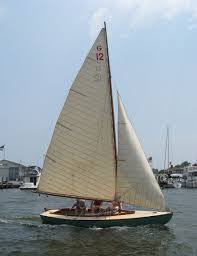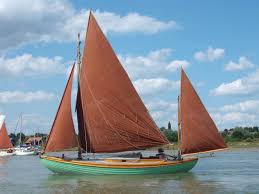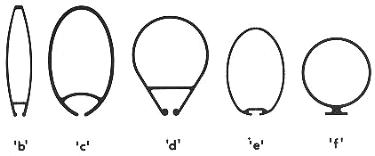SAILING / LIFE #9 - About Those Spars…
What Are They? For those unfamiliar with the term, a sailboat’s spars are the rigid components of a sailing rig. They include the boat’s masts, booms, gaffs, yards, sprits, poles, and spreaders – all of which exist to support the boat’s sails. These components, together with the cables that hold them in place and reinforce their rigidity (called stays and shrouds) comprise the boat’s fixed rigging, while the ropes or cables that control the motion of the sails and the hardware used with them are called the running rigging. Specifically, those that raise and lower the sails are called halyards while those that control their lateral motion are called sheets. The hardware includes blocks or pulleys, travelers that control the location of the blocks, winches that provide the leverage to tension the sheets and halyards, and stoppers that let one adjustably lock down the tail end of a halyard or sheet. There are also various devices for furling sails, or rolling them up in order tho reduce their exposure to the wind.
Scope of this Summary There has been a great deal of innovation in sails and sailing rigs over the years past, and whole books written on the subject, so I’ll not be attempting to duplicate all that lore here. Instead, I’ll explain what I believe to be the most essential knowledge for the cruising sailor. In choosing this material, I am keeping in mind that a cruising rig needs to be sturdy, reliable, and readily maintainable. To these ends it is often wise to make it as simple as possible while also keeping within the parameters dictated by the usage of the boat, the experience and size of the crew, and the possibility of encountering stressful emergencies at sea.
My own personal preference is to equip the boat in such a way that I could sail it alone if I had to – because one never knows when illness, injury, or even death might make other crew members unavailable.
Mast Configuration The first consideration concerning masts is the question of how many you want to have aboard your boat. Other things being equal, I’d suggest having two or three. This redundancy will make it less likely that you will find yourself with no mast at all if a storm deprives you of one. Another advantage of multiple masts is that for a given total sail area one requires smaller sails, and this makes the sails easier to handle and control. Matching sail design to the rest of a boat design is a job for a naval architect or marine engineer. While it may seem overkill to have three masts, it is not uncommon for a Chinese junk rig on a 40 footer to have three – and the junk is one of the oldest an most reliable rigs to be found. Although a three-masted boat will be heavier than the same boat with only one mast, light weight and speed are not the primary criteria for a cruising vessel. 
Single Mast Rigs
Among modern single-masted boats, the sloop and the cutter are top choices. Each has advantages and disadvantages. - the sloop rig being a little simpler, while the cutter is somewhat more versatile. The primary difference lies in the fact that the mast is further forward on a sloop. The mainsail is usually bigger and the sail area forward of the mast uses smaller jibs.


Two Masted Rigs The most common two masted rigs are the ketch, the yawl, and the schooner. Properly designed and constructed, all three can be quite serviceable aboard cruising sailboats. Having multiple masts increases one’s flexibility in balancing the sails and tuning the rig to match the sea and wind conditions that one encounters while cruising.
The ketch rig places the larger mainsail forward of amidships while the mizzen sail is on a smaller mast behind it. The two sails usually both have horizontal booms and the mizzen boom usually doesn’t extend beyond the limit of the boat’s stern. Jibs are usually attached to the main fore-stay and, except for a small storm jib, are likely to extend aft of the main mast. This often means that tacking requires one to manually lead the aft end of the jib around the front of the mast. Twin sheets control the sail depending on which side the wind is on. 
The traditional schooner places the larger mast farther aft than the ketch, and supports a smaller foremast in front of it. For this reason schooners often have bowsprits to allow the jibs to be mounted forward of the boat’s bow. This increases sail area, but it makes it more dangerous to attach or detach the jibs in rough weather.
Another common feature of the traditional schooner is the gaff – a spar mounted on the mast at the top of the mainsail. While this permits addition of another small sail, I regard the additional complexity and topside weight to be undesirable, preferring the so-called Marconi rig illustrated below. This arrangement means one less spar, one less halyard, one less winch, and easier sail-handling.
Materials and Construction Spars were traditionally made of wood, and could either be solid, like a tree-trunk, or hollow. Well built hollow ones are preferable, because they can be almost as strong while being much lighter. These days the most common spars are constructed of aluminum extrusions - the more expensive ones being made to taper by welding up extrusions of different sizes. Some are made with a slot down their aft side and a furling roller inside the mast. These are aerodynamically good and convenient for shortening sail in heavy weather, but I frankly don’t trust them. There is no way the slot can fail to diminish the spar’s strength. Even a conventional mast without a slot can buckle and collapse if not properly supported by the stays and shrouds attaching it to the boat's hull. 
The most modern mast construction, and certainly the most expensive, is the unstayed carbon fiber epoxy composite that requires neither stays nor shrouds to keep it upright under all weather conditions. In a modern schooner configuration, illustrated below, this technology not only avoids the necessity of many components of conventional aluminum masts, but also greatly simplifies the work of sailing the boat. When you want to tack, you just steer across the wind, and the rig manages itself. No more going forward to haul the jib around the mast. No more need for twin sheets on jibs. No more risky acrobatics walking the bowsprit to change sails. And some designs of this type even do away with the need for booms. While this rig is more costly than the others, it offers serious advantages for the cruising sailor. 
That’s it for now. Until next time, Happy Sails!

Congratulations @borisheir! You have completed some achievement on Steemit and have been rewarded with new badge(s) :
Click on any badge to view your own Board of Honor on SteemitBoard.
For more information about SteemitBoard, click here
If you no longer want to receive notifications, reply to this comment with the word
STOP